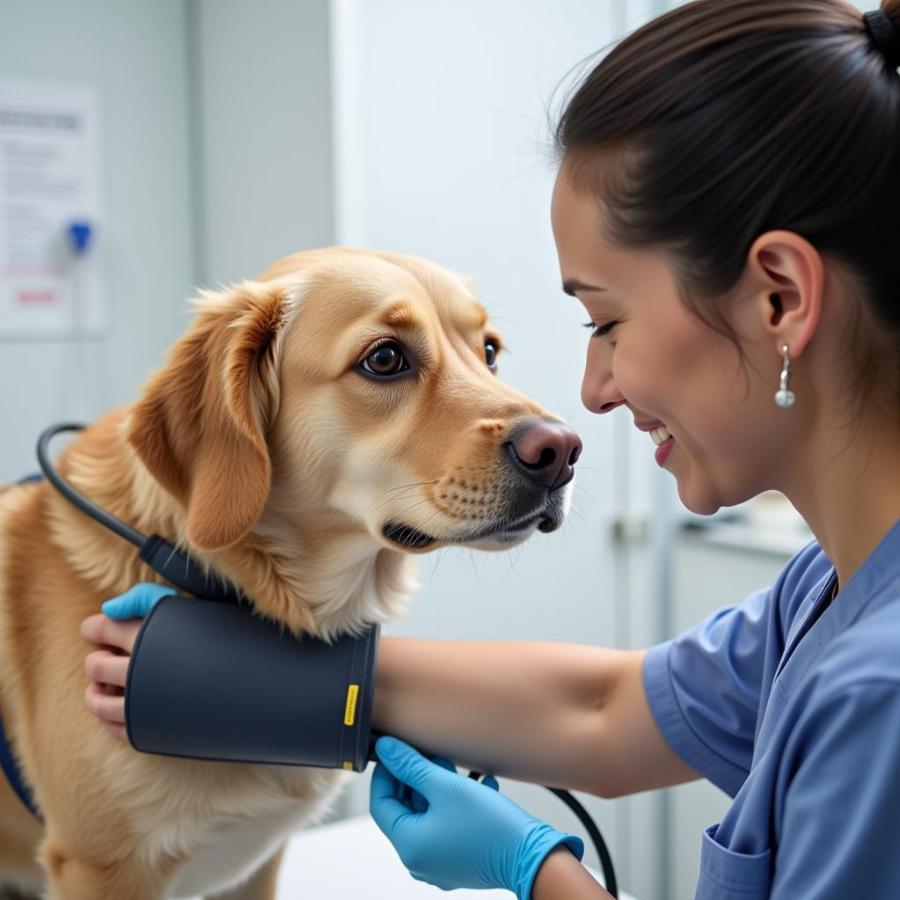Knowing your dog’s blood pressure is crucial for maintaining their overall health. Just like in humans, high blood pressure in dogs can lead to serious health issues, including kidney disease, heart failure, and even blindness. Using a blood pressure cuff for dogs allows veterinarians to detect these potential problems early and implement appropriate treatment plans. This article will delve into the importance of monitoring canine blood pressure, how to use a blood pressure cuff for dogs effectively, and what to expect during the process.
Understanding the Importance of Canine Blood Pressure Monitoring
Regular blood pressure checks are especially important for senior dogs and those with pre-existing conditions like kidney or heart disease. Early detection of hypertension can significantly improve a dog’s prognosis and quality of life. While many pet owners may not be aware of this vital health metric, it’s becoming increasingly recognized as an essential part of preventative veterinary care. Just as regular check-ups are crucial for our own health, monitoring our furry friends’ blood pressure is equally important.
 Checking Dog's Blood Pressure
Checking Dog's Blood Pressure
How to Use a Blood Pressure Cuff for Dogs
While the procedure might sound complicated, measuring a dog’s blood pressure is relatively straightforward with the right equipment and technique. A dog blood pressure monitor is specifically designed to fit comfortably around a dog’s leg or tail. The cuff is inflated to temporarily restrict blood flow, and then slowly deflated while a sensor monitors the returning pulse. This information is then translated into a blood pressure reading.
Choosing the Right Cuff Size
Just as with humans, using the correct cuff size is crucial for accurate readings. Too small a cuff can lead to artificially high readings, while a cuff that’s too large can result in falsely low readings. Your veterinarian can help you determine the appropriate size for your dog based on their breed and weight.
What to Expect During a Canine Blood Pressure Check
The process is generally quick and painless. Your veterinarian will typically shave a small area of fur on your dog’s leg or tail to ensure proper contact with the sensor. The cuff will then be placed around the limb and inflated. Some dogs may experience slight discomfort or anxiety during the procedure, but most tolerate it well.
Interpreting the Results
Your veterinarian will interpret the blood pressure readings and discuss any concerns or necessary next steps. Normal blood pressure in dogs typically falls within a specific range, but individual variations can occur. Consistent high readings may indicate hypertension, requiring further investigation and treatment.
Signs of High Blood Pressure in Dogs
While regular blood pressure checks are essential, being aware of potential signs of hypertension can help you seek timely veterinary care. These signs can include:
- Nose bleeds
- Lethargy
- Changes in vision
- Seizures
Keeping Your Dog Calm During the Procedure
A stressed dog can have elevated blood pressure readings. To ensure accuracy, it’s crucial to keep your dog as calm and relaxed as possible. Talk to your veterinarian about techniques for calming your dog, such as using treats, gentle petting, or even playing soothing music during the procedure.
Conclusion
Monitoring your dog’s blood pressure with a dog blood pressure monitor is a vital aspect of their overall health care. Regular checks, especially for senior dogs or those with pre-existing conditions, can help detect potential problems early and improve their quality of life. By understanding the importance of canine blood pressure monitoring and how the process works, you can play an active role in ensuring your furry friend’s long-term health and well-being. Remember to consult your veterinarian for personalized advice and guidance on monitoring your dog’s blood pressure.
FAQ
-
How often should my dog’s blood pressure be checked? This depends on your dog’s age, health, and any underlying conditions. Discuss this with your veterinarian to determine the appropriate frequency for your dog.
-
Can I take my dog’s blood pressure at home? While home blood pressure monitors for dogs are available, it’s best to have this done by a trained veterinarian to ensure accuracy and proper interpretation of the readings.
-
Is high blood pressure painful for dogs? High blood pressure itself is not typically painful, but the health complications it can cause, such as kidney damage or eye problems, can be.
-
What are the treatment options for high blood pressure in dogs? Treatment varies depending on the underlying cause and severity of the hypertension. Your veterinarian may recommend medications, dietary changes, or other lifestyle modifications.
-
Are certain breeds more prone to high blood pressure? Yes, some breeds are predisposed to hypertension, including Greyhounds, Dachshunds, and Poodles.
-
Can stress affect blood pressure readings in dogs? Absolutely. Stress and anxiety can significantly elevate a dog’s blood pressure, making it important to create a calm and comfortable environment during the measurement process.
-
What should I do if I suspect my dog has high blood pressure? Contact your veterinarian immediately to schedule an appointment and discuss your concerns.
Beaut Dogs is your go-to resource for all things canine, providing reliable, informative, and in-depth knowledge about the wonderful world of dogs. From breed characteristics and care tips to health advice and product reviews, Beaut Dogs is dedicated to helping you provide the best possible care for your furry companion. When you need assistance, please contact Email: [email protected] to get detailed and accurate answers from Beaut Dogs.